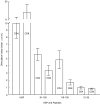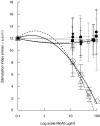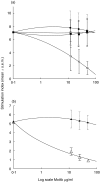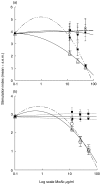Defining a T-cell epitope within HSP 65 in recurrent aphthous stomatitis
- PMID: 11985522
- PMCID: PMC1906391
- DOI: 10.1046/j.1365-2249.2002.01757.x
Defining a T-cell epitope within HSP 65 in recurrent aphthous stomatitis
Abstract
The 65 kD heat shock protein (HSP) has been implicated in the aetiology of recurrent aphthous stomatitis (RAS). We have previously demonstrated that peptide 91-105 derived from the sequence of mycobacterial 65 kD HSP stimulates specifically lymphocytes from patients with RAS. In this investigation, we show that both CD4+ and CD8+ T cells were significantly stimulated with mycobacterial peptide 91-105. In contrast, the human homologous peptide 116-130 stimulated only CD4+ T cells. Inhibition studies showed that CD4+ T cells were class II restricted, whereas CD8+ T cells were class I restricted. We then used truncated or substituted peptides, and demonstrated that residues 95-105 appear to be important, and residue 104(Arg) critical, in stimulating the T cells. Thus, peptide 95- 105 may constitute a T-cell proliferative epitope in RAS. We postulate that the high load of micro-organisms that colonize the oral mucosa may initiate an immune response by the microbial HSP 65-derived peptide 95-105, stimulating the numerous Langerhans cells in the oral mucosa to activate a cross-reacting immune response to the homologous peptide 116-130 within the epithelial HSP 60, initiating the immunopathological changes that lead to RAS.
Figures






Similar articles
-
Recognition of a unique peptide epitope of the mycobacterial and human heat shock protein 65-60 antigen by T cells of patients with recurrent oral ulcers.Clin Exp Immunol. 1995 Mar;99(3):392-7. doi: 10.1111/j.1365-2249.1995.tb05563.x. Clin Exp Immunol. 1995. PMID: 7533679 Free PMC article.
-
T cells recognize an immunodominant epitope of heat shock protein 65 in Kawasaki disease.Mol Med. 2000 Jul;6(7):581-90. Mol Med. 2000. PMID: 10997339 Free PMC article.
-
T cell epitope expression of mycobacterial and homologous human 65-kilodalton heat shock protein peptides in short term cell lines from patients with Behçet's disease.J Immunol. 1993 Aug 15;151(4):2273-82. J Immunol. 1993. PMID: 7688396
-
T cell recognition of a highly conserved epitope in heat shock protein 60: self-tolerance maintained by TCR distinguishing between asparagine and aspartic acid.Int Immunol. 2004 Mar;16(3):405-14. doi: 10.1093/intimm/dxh032. Int Immunol. 2004. PMID: 14978014
-
Oral epithelial barrier function and the role of nuclear factor kappa-β pathway in the pathogenesis of aphthous ulceration.Turk J Gastroenterol. 2013;24(6):508-14. doi: 10.4318/tjg.2013.0334. Turk J Gastroenterol. 2013. PMID: 24623290 Review.
Cited by
-
Recurrent aphthous stomatitis.Dent Clin North Am. 2014 Apr;58(2):281-97. doi: 10.1016/j.cden.2013.12.002. Epub 2014 Jan 21. Dent Clin North Am. 2014. PMID: 24655523 Free PMC article. Review.
-
"Ozone" - the new NEMESIS of canker sore.J Clin Diagn Res. 2015 Mar;9(3):ZC01-4. doi: 10.7860/JCDR/2015/11911.5617. Epub 2015 Mar 1. J Clin Diagn Res. 2015. PMID: 25954693 Free PMC article.
-
The immune responses to human and microbial heat shock proteins in periodontal disease with and without coronary heart disease.Clin Exp Immunol. 2005 Dec;142(3):585-94. doi: 10.1111/j.1365-2249.2005.02953.x. Clin Exp Immunol. 2005. PMID: 16297172 Free PMC article.
-
A novel atherogenic epitope from Mycobacterium tuberculosis heat shock protein 65 enhances atherosclerosis in rabbit and LDL receptor-deficient mice.Heart Vessels. 2012 Jul;27(4):411-8. doi: 10.1007/s00380-011-0183-8. Epub 2011 Oct 29. Heart Vessels. 2012. PMID: 22038107
-
Diminished forkhead box P3/CD25 double-positive T regulatory cells are associated with the increased nuclear factor-kappaB ligand (RANKL+) T cells in bone resorption lesion of periodontal disease.Clin Exp Immunol. 2007 May;148(2):271-80. doi: 10.1111/j.1365-2249.2006.03318.x. Epub 2007 Mar 9. Clin Exp Immunol. 2007. PMID: 17355249 Free PMC article.
References
-
- Sircus W, Church R, Kelleher J. Recurrent aphthous ulceration of the mouth. Qly J Med. 1957;26:235–42. - PubMed
-
- Lehner T. Recurrent aphthous ulceration and autoimmunity. Lancet. 1964;2:1154–5. - PubMed
-
- Graykowski EA, Barile MF, Lee WB, Stanley HR. Recurrent aphthous stomatitis. Clinical, therapeutic, histopathologic and hypersensitivity aspects. J Am Med Assoc. 1966;196:637–44. - PubMed
-
- Donatsky O. A leukoctye migration study on the cell-mediated immunity against adult human oral mucosa and streptococcal antigens in patients with recurrent aphthous stomatitis. Arch Dermatol. 1974;109:361–3. - PubMed
Publication types
MeSH terms
Substances
LinkOut - more resources
Full Text Sources
Medical
Research Materials

